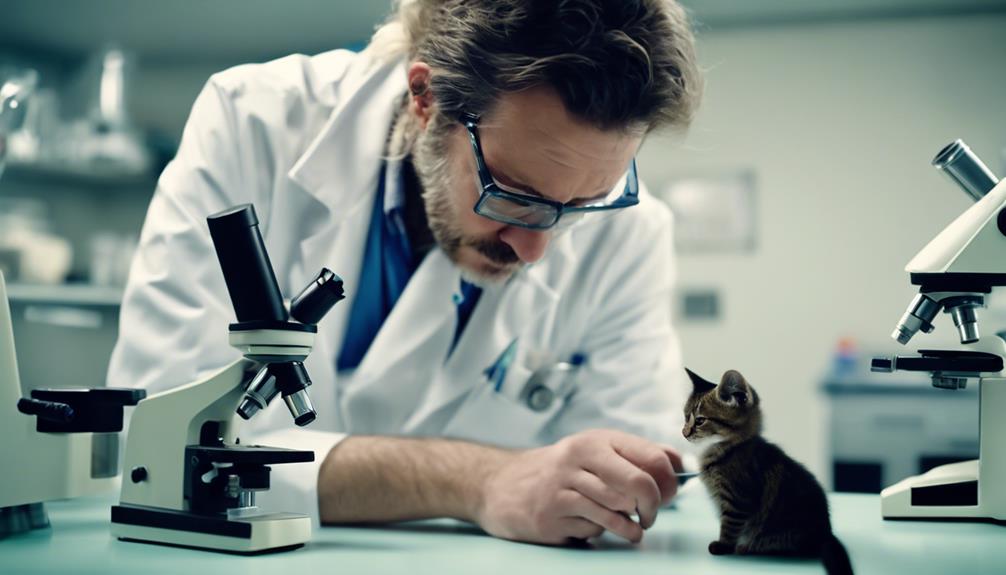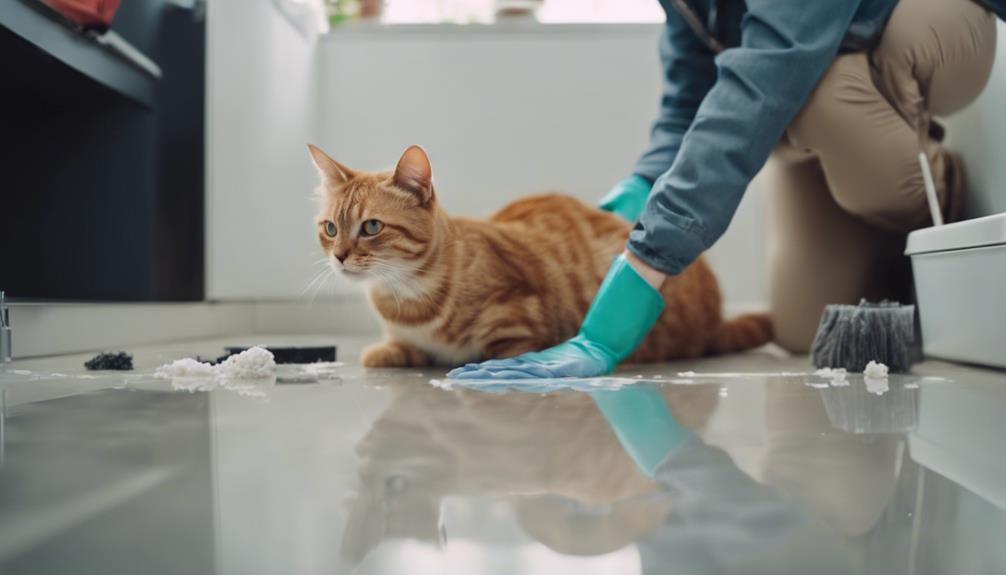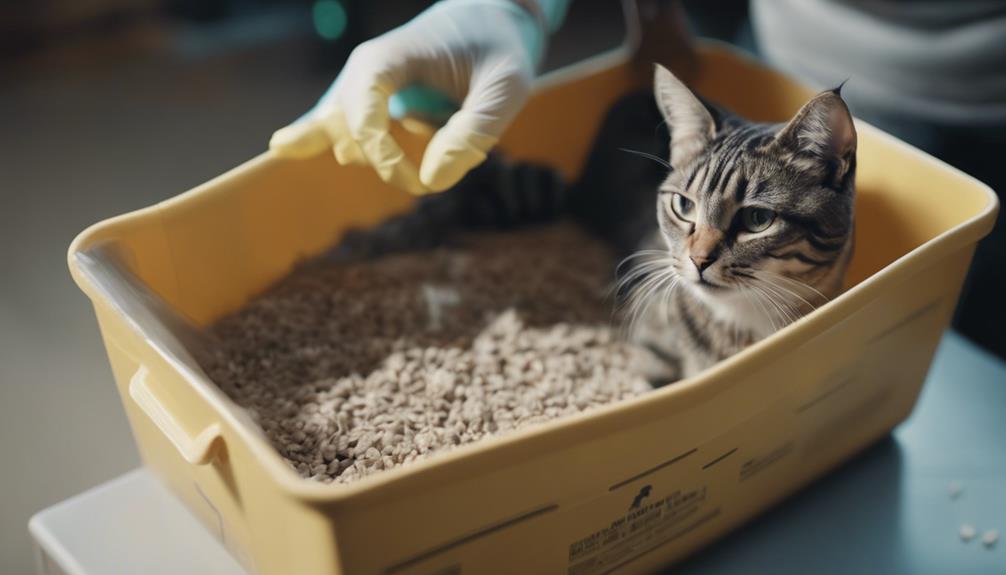The intricate interplay between feline health and the insidious Toxoplasmosis parasite unveils a realm of complexities that necessitate meticulous attention. From the silent threat posed by T. gondii to the nuanced symptoms exhibited by infected felines, the landscape of this parasitic infection unravels a tapestry of challenges that extend beyond mere awareness.
As the web of transmission expands to encompass both feline and human realms, the imperative for informed actions becomes apparent. In this exploration of Toxoplasmosis facts, a deeper understanding of diagnostic, treatment, and preventive measures emerges, underscoring the urgency of proactive measures to mitigate this lurking menace.
Key Takeaways
- Toxoplasmosis in cats is often asymptomatic, making regular testing important.
- Cats can transmit the parasite through contaminated feces, posing a risk to pregnant women.
- Prevention strategies include indoor living, cooked food, and litter box hygiene.
- Diagnosis and treatment for toxoplasmosis in cats involve antibody testing and antimicrobial drugs.
Cats and Toxoplasmosis
Cats play a pivotal role in the transmission and ecology of toxoplasmosis, a disease caused by the protozoa parasite T. gondii. They usually become infected by consuming contaminated meat. Interestingly, cats can carry T. gondii without displaying any symptoms. However, immunocompromised felines are at a higher risk of developing the disease.
Symptoms in cats can vary depending on the organs affected by the parasite. To prevent the transmission of toxoplasmosis, it is essential to keep cats indoors to avoid hunting infected prey and feed them cooked, canned, or dry commercial foods. Additionally, regular cleaning of litter boxes and thorough handwashing are crucial steps in minimizing the risk of transmission of this disease through cat feces.
Human Transmission Risk Factors
Human transmission risk factors for toxoplasmosis primarily stem from exposure to contaminated environments and specific activities rather than direct contact with cats. Despite cats being the natural hosts of the T. gondii parasite, humans are more likely to acquire the infection through other means.
To reduce the risk of transmission, individuals should be cautious with the following factors:
- Handling and consuming undercooked meat, particularly pork, lamb, and venison.
- Contact with contaminated soil while gardening or during outdoor activities.
- Ingestion of water or food contaminated with oocysts shed by infected cats.
Diagnosing Toxoplasmosis in Cats

Exposure to Toxoplasma gondii, the parasite responsible for toxoplasmosis, can manifest in cats through various symptoms affecting different organs, necessitating an accurate and timely diagnosis for effective management.
Diagnosing toxoplasmosis in cats typically involves testing for antibodies to the parasite. This can be accomplished through a simple blood test. The presence of these antibodies indicates exposure to the parasite, but it is important to note that a positive test result does not always correlate with active disease.
Should clinical signs be present, additional tests such as imaging studies or tissue biopsies may be necessary to confirm the diagnosis. Early detection and prompt treatment are crucial in improving the prognosis for cats infected with toxoplasmosis.
Treatment Options for Infected Cats
When addressing toxoplasmosis in feline patients, the treatment options available focus on managing the signs of the infection and promoting recovery. Treatment for infected cats may include the following:
- Antimicrobial Drugs: Medications can be prescribed to help alleviate the signs of toxoplasmosis and combat the parasite within the cat's body.
- Supportive Care: Providing supportive care such as fluids, proper nutrition, and a comfortable environment can aid in the cat's recovery process.
- Regular Monitoring: It is essential to closely monitor the cat's progress during treatment to assess the effectiveness of the chosen therapy and make any necessary adjustments.
Preventing Toxoplasmosis in Cats

To mitigate the risk of toxoplasmosis in cats, implementing preventive measures is crucial for maintaining feline health and well-being. Preventive strategies include keeping cats indoors to prevent hunting of infected prey, feeding them cooked, canned, or dry commercial foods, avoiding raw meat, cleaning litter boxes daily, and practicing thorough handwashing. Pregnant women should refrain from handling cat litter to reduce the risk of transmission. By following these preventative measures, cat owners can help safeguard their feline companions from contracting toxoplasmosis.
| Preventive Measures | Description |
|---|---|
| Keep cats indoors | Prevent hunting of infected prey |
| Feed cooked, canned, or dry commercial foods | Avoid raw meat |
| Clean litter boxes daily | Reduce exposure to oocysts |
Preventing Human Transmission
To safeguard against the transmission of toxoplasmosis to humans, adherence to specific preventive measures is imperative, especially for individuals at higher risk such as pregnant women.
Key Preventive Measures:
- Avoid Handling Cat Litter: Pregnant women should refrain from cleaning cat litter boxes, as T. gondii oocysts can be present in feces and pose a risk of transmission.
- Practice Good Hygiene: Thoroughly wash hands after any contact with cats, their litter, or potentially contaminated soil to reduce the risk of infection.
- Cook Meat Thoroughly: Ensure meat is cooked to safe temperatures to kill any potential T. gondii cysts, reducing the risk of contracting the parasite through food consumption.
Hygiene Practices for Cat Owners

Maintaining proper hygiene practices is essential for cat owners to minimize the risk of toxoplasmosis transmission and ensure the health and safety of both their feline companions and themselves.
Regularly cleaning the litter box, preferably on a daily basis, is crucial as T. gondii oocysts in cat feces can become infectious.
Washing hands thoroughly after handling cats, especially before eating or preparing food, is vital to prevent potential contamination.
Cat owners should also avoid contact with stray cats or wild animals that may carry the parasite.
Keeping indoor cats and feeding them commercial foods instead of raw meat can further reduce the risk of toxoplasmosis transmission.
Rare Transmission Scenarios
Uncommon routes of transmission for toxoplasmosis in humans include rare occurrences such as organ transplantation and blood transfusions. These scenarios, although infrequent, underscore the importance of understanding potential sources of infection. When considering these rare transmission pathways:
- Organ Transplantation: Instances where organs from infected donors are transplanted can lead to toxoplasmosis transmission.
- Blood Transfusions: Although rare, receiving blood from a donor with toxoplasmosis can result in the parasite entering the recipient's bloodstream.
- Medical Precautions: Healthcare providers must take appropriate measures to screen donors and ensure the safety of organ transplants and blood transfusions.
Frequently Asked Questions
Can Toxoplasmosis Be Transmitted Between Cats?
Yes, toxoplasmosis can be transmitted between cats. T. gondii, the protozoa parasite causing toxoplasmosis, can spread through ingestion of infected meat or exposure to contaminated soil. Cats can carry the parasite without showing symptoms.
Are There Any Long-Term Effects on Cats Who Have Recovered From Toxoplasmosis?
Long-term effects on cats who have recovered from toxoplasmosis may vary depending on the severity of the initial infection. While some cats may fully recover, others might experience lingering health issues, particularly if vital organs were affected.
Is There a Vaccine Available for Toxoplasmosis in Cats?
Currently, there is no commercially available vaccine for toxoplasmosis in cats. Prevention methods such as keeping cats indoors, feeding them cooked foods, and maintaining good hygiene practices are recommended to minimize the risk of infection.
Can Indoor Cats Still Be at Risk of Contracting Toxoplasmosis?
Indoor cats can still be at risk of contracting toxoplasmosis through ingestion of contaminated food or water sources. It is important to follow preventive measures, such as feeding commercial foods, daily litter box cleaning, and practicing good hygiene.
Are There Any Natural Remedies or Supplements That Can Help Boost a Cat's Immune System Against Toxoplasmosis?
Natural remedies or supplements to boost a cat's immune system against toxoplasmosis are not a substitute for veterinary care. Consult a veterinarian for appropriate diagnosis, treatment, and prevention measures tailored to your cat's health needs.
How does Toxoplasmosis Compare to Giardia in Cats?
Toxoplasmosis and Giardia are both common parasitic infections in cats. While Toxoplasmosis can cause mild symptoms, Giardia can lead to gastrointestinal issues. The signs of giardia in cats include diarrhea, vomiting, and weight loss. It’s important to monitor your cat’s health and seek veterinary care if necessary.
Conclusion
In conclusion, Toxoplasmosis presents a significant health concern for both cats and humans due to its complex nature and potential transmission risks.
Understanding the symptoms, diagnosis, treatment, and preventive measures is crucial in mitigating the impact of this parasitic infection.
By implementing informed care practices and maintaining proper hygiene, both feline companions and their human counterparts can coexist in a healthier environment free from the risks associated with Toxoplasmosis.




